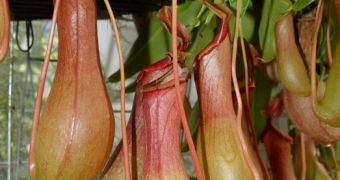These are the most impressive carnivorous plants, having spectacular traps: pitcher plants (Nepenthes), growing in various places, from Madagascar and southeastern Asia to northeastern Australia. The 117 species are also dubbed "Monkey cups" as monkeys have been spotted drinking rainwater from them. These plants are epiphytes in the rain forest, and as they cannot extract nitrogen and phosphorous from the soil, they do it from the insect bodies.
The leaf continues with a tendril than ends with the pitcher trap. The trap hosts a fluid of the plant's own production, which may be watery or syrupy, and is used to drown the prey. The lower part of the trap contains glands which absorb nutrients from captured prey.
Along the upper inside part of the trap there is a slick waxy coating that impedes the escape of its prey. The trap entrance is surrounded by a structure called peristome ("lip"), which is slippery and often quite colorful, attracting prey but offering an unsure footing. Above the peristome, there is a lid (the operculum): in many species this keeps rain from diluting the fluid within the pitcher, the underside of which may contain nectar glands that attract prey.
The trap can be 50 cm (20 inch) long and 15 cm (6 inch) wide. The plants usually catch insects, but the prey can range from rats to song birds or lizards!
The digestive enzymes of Nepenthes can dissolve even the nitrogen rich insect chitin, which most insectivorous animals cannot digest. But no one has known the full chemical mixture for the Nepenthes' "gut juices". A new Japanese research published in the ACS' Journal of Proteome Research has solved this issue.
The team made by Tatsuro Hamada and Naoya Hatano employed cutting-edge proteomic analysis to detect the chemical composition of the digestive fluid. 7 digestive proteins were found to be specific to Nepenthes (3 of them, to the research species, N. alata). Some of these proteins were antibacterial, impeding the prey from rotting, while being slowly digested by the plant. Some medicine and agriculture benefits may result from their further investigation.

 14 DAY TRIAL //
14 DAY TRIAL //